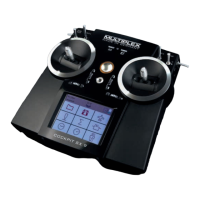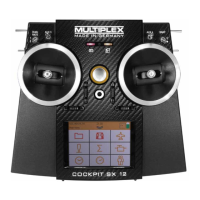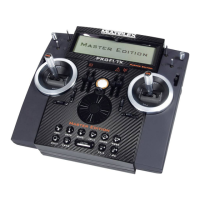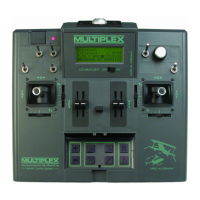MULTIPLEX
mechanically obstructed (stalled) at either end-
point (maximum travel).
• Adjust the horns, output arms and linkages as
accurately as possible, taking care to keep lost
motion (slop) to an absolute minimum. This
avoids overloading the servos, which are then
able to exploit their full potential performance.
These measures ensure that the servos have a
long useful life, providing the highest possible
margin of safety.
• Provide effective protection for the receiver, the
batteries, the servos and the other RC com-
ponents, and observe the notes in the operating
instructions supplied with them. An important fac-
tor in this is the correct balancing of propellers
and rotors. Any part of a power system which is
damaged or runs out of true must be replaced at
once.
• Do not place cables under strain, do not kink
them, and do protect them from rotating parts.
• Avoid unnecessarily long or superfluous servo
extension leads, and always use cable of ade-
quate conductor cross-section (voltage loss). We
recommend at least 0.24 mm
2
as a starting point.
• Take appropriate measures to avoid interference
due to static charge, powerful electrical or electro-
magnetic fields (this includes the suppression of
electric motors with suitable capacitors), and keep
such sources well away from the RC system, the
receiver aerial, wiring and batteries.
• Maintain adequate spacing between cables which
carry high currents (e.g. electric power system
leads) and the RC system. In particular the cables
between brushless electric motors and their
speed controllers must be kept short (max. 10 to
15 cm if possible).
• Check all functions carefully, and ensure that you
are properly familiar with the method of operating
your transmitter before using it to control a model.
You should also examine your model at regular inter-
vals, checking the following points in particular:
• Check that control surfaces and linkages are free-
moving and devoid of lost motion (slop);
• Check that pushrods, other linkage components,
hinges, etc. are strong enough and in perfect con-
dition;
• Look for fractures, cracks and distortions in the
model, the RC components and the power sys-
tem;
• All cables and connectors must be in good con-
dition and make reliable contact;
• Check the condition of the power supply system
and wiring, including the switch harness, and the
external condition of the battery cells. This also in-
cludes the use of appropriate charging proce-
dures to match the battery type, and regular main-
tenance of the batteries themselves.
Pay particular attention to the system’s power sup-
plies: both in the transmitter and in the model.
• Remove the dry cells from the transmitter if you know
you will not be using it for a long period, as they could
leak and cause damage.
• Always fit new dry cells after a protracted period of non-
use.
• If you hear the voltage monitor warning sound, land
your model (or otherwise cease operations) immediate-
ly. Change the dry cells for new ones of the correct
type.
• Never attempt to recharge dry cells, as they could ex-
plode.
• At regular intervals check the state of the receiver bat-
tery or batteries, and the BEC system.
• Rechargeable batteries must be charged regularly;
never wait until the servos’ movements are perceptibly
slower. Make it a rule to charge your batteries before
every flying session.
• If you are using rechargeable cells, it is essential to ob-
serve the charging instructions provided by their manu-
facturer.
Before every flight carry out the following procedures and
checks:
• Carefully charge up the transmitter, receiver and flight
batteries, and check their state of charge regularly dur-
ing the session and between flights.
• When you arrive at the launch point, register with the
site warden or flight director, and do not switch ON until
you have checked with the other pilots present that
your channel is free.
• Check that all control functions and auxiliary functions
are working correctly and in the correct “sense” (direc-
tion).
If you discover a problem, do not launch the model.
First seek the fault, eliminate it, and check again.
When operating your model you should always observe the
following points:
• If you have no experience in flying a model aeroplane,
please ask a skilled pilot to help you initially. A Trainer
system is a great help during the early stages.
• Only fly your model at a suitable site. Never operate a
model in the vicinity of buildings or roads.
• Do not fly or steer your model over or towards spec-
tators. Never place people or animals in danger.
• Do not carry out any high-risk flying or driving manoeu-
vres.
• In Germany and in many other countries it is a legal re-
quirement to take out third-party insurance cover for the
operation of model aircraft. Find out the exact legal re-
quirements for your region, and observe them strictly.
• Be realistic when assessing your own skills and capa-
bilities; don’t over-estimate what you can do.
• If you notice any sign of a problem or interference, land
your model immediately, or cease operations.
• Static charge hazard!
In extremely dry air (in mountainous terrain and on
steep slopes close to weather fronts) static charges
may develop in the transmitter and / or the pilot. Such a
charge may be dissipated by a static spark which could
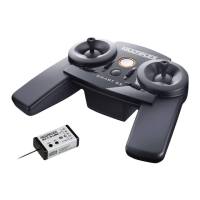
